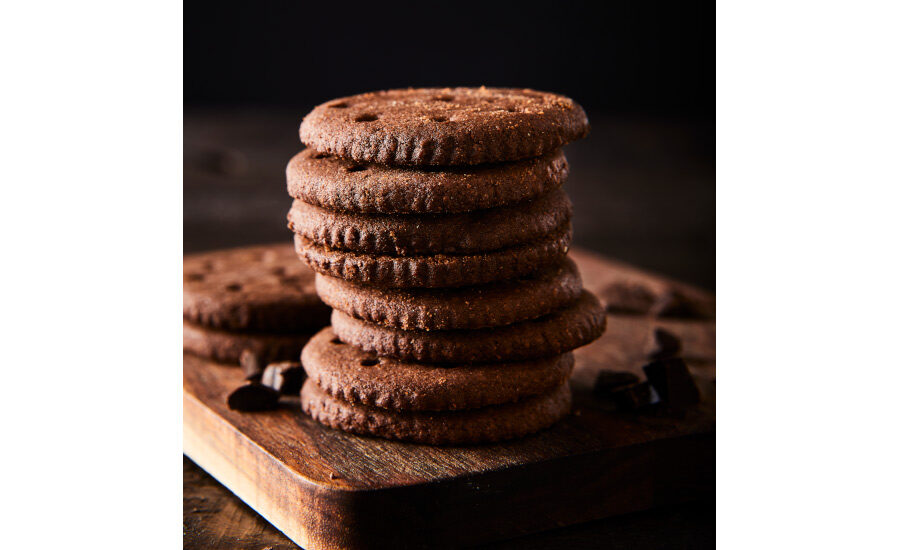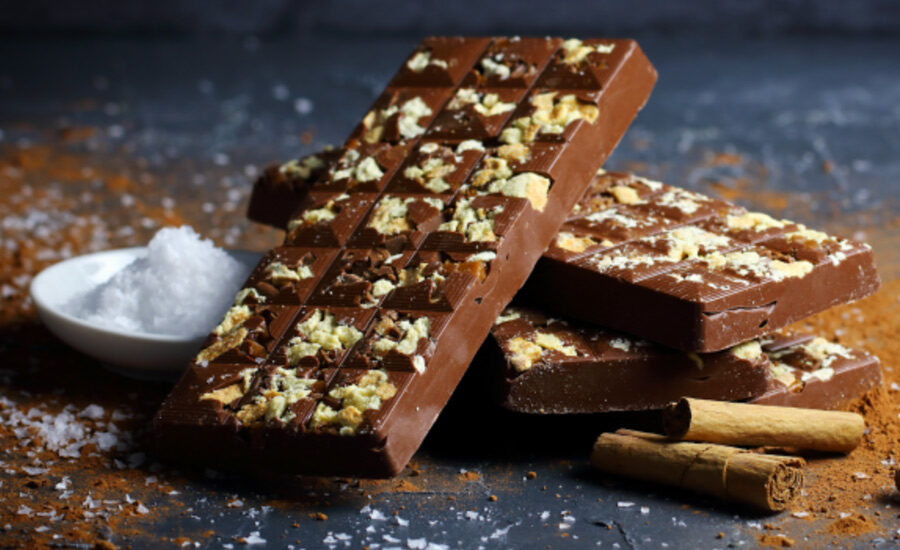Searching for better-for-you, yet indulgent, chocolate ingredients
When it comes to chocolate, consumers want it all: indulgence, better-for-you choices, and sustainability.








Everyone loves chocolate: In fact, according to recent Statista data, 268 million Americans consumed chocolate and other candy in 2020.
Cargill, Minneapolis, shared insights from its proprietary ChocoLogic survey to understand consumers’ attitudes and preferences for chocolate by itself and also when incorporated into snack and bakery products. The company explored various positionings to see what resonated with consumers.
“We found simple, more familiar claims such as ‘made with real chocolate,’ and ‘no artificial ingredients’ rose to the top. ChocoLogic also revealed that interest in premium chocolate remains high, with cacao content and claims around provenance among the cues that consumers use to judge quality. In the snack and bakery space, brands can leverage this insight by highlighting these attributes on pack,” shares Gretchen Hadden, marketing manager, Cargill Cocoa & Chocolate, North America.
Throughout the pandemic, consumers gravitated to chocolate to help provide both indulgence and comfort. As we begin to emerge, consumers have a heightened interest in their health and wellbeing.
A tale of two trends
At Barry Callebaut, the company sees two clear pathways for chocolate experiences with consumers: either pure indulgence or a better-for-you path. “Ultimately, consumers are looking for that middle ground, of that triple play, tastes great, better for me and good for the planet. Either way, consumers will not compromise on taste so that is a must in either pathway,” explains Laura Bergan, director of brand, marketing, Barry Callebaut, Chicago. One example of the company’s newest indulgent offering is their new ruby chocolate, the fourth type of chocolate for the industry.
“Ruby delivers on extreme indulgence that is particularly appealing to the younger generations because it offers a new taste and flavor experience of luscious and premium chocolate. Ruby comes from a specific variety of ruby cocoa bean in combination with our unique processing … these two together make ruby.” Ruby can be used for drizzling, enrobing clusters, or for an indulgent panned nut or fruit center.
The company also recently introduced a new innovative cocoa powder called Natural Dark. “Natural Dark is a new revolutionary cocoa powder that delivers on impactful rich cocoa flavor and taste while offering a clean label with no alkalization process, that is standard in order to reach dark, flavorful powders. Most natural cocoa powders (without the alkalization step) are much lighter in color and taste,” shares Bergan. Natural Dark works well in cookies, brownies, cakes, muffins, and scones.
Along the lines of better-for-you, Barry Callebaut recently launched a new dairy-free high protein, plant-based dark chocolate to add to its Dairy-Free Pathway chocolate line. “This chocolate offers the same rich dark chocolate experience as other dark chocolates but includes the added proposition that it is dairy-free and contains a 20 percent protein level. This can help amplify protein content in the final consumer product,” states Bergan. A good example of where this new product could be used would be in popular plant-based snacks such as clusters or panned items such as nuts.
“Consumers still crave familiar comfort foods classic and indulgent flavors,” says Wouter Stomph, head, North America cocoa ingredient development and innovation, Olam Food Ingredients, Fresno CA. The classic brownie remains one of the most popular bakery products in the world, he says, accounting for 58 percent of new cake, pastry, and sweet goods launches last year, citing Innova Market Insights data, while flavors like cocoa and milk and dark chocolate continue to top the charts. “However, consumer tastes are also changing to reflect the appetite for healthier, guilt-free indulgence and more intense flavors like spices and botanicals, are moving into the mainstream. When combined with cocoa, these stronger notes can create intense flavors consumers crave, without the need for lots of sugar or additives.”
In response to consumers’ continued interest in indulgent experiences, the company offers darker red cocoa powder for example deZaan D11RB which helps to create a premium, indulgent feel by providing a distinctive flavor and extreme dark brown color. The product works well in muffins and other cakes. For an even more visually striking product, deZaan D11B can be used to produce a black cookie with an intense cocoa flavor.
Stomph is seeing novel flavor pairings—spices, herbals, and botanicals are on the rise. He shares examples of how these new and novel flavors are being used in combination with cocoa. “We’re increasingly seeing cocoa used in combination with functional ingredients as health-conscious consumers look for foods that taste great but also come with added health, wellness and immune boosting benefits. New entrants to the snack and bakery category are mixing cocoa with functional ingredients like ginger or turmeric, both used in herbal medicine for their antioxidant, anti-inflammatory, and anti-cancer properties, while botanicals like angelica root and garlic are becoming popular because of their positive impact on energy and immunity.”
Chocolate chile represents an example of cocoa being blended with a spice. “The spice of the chile distracts from the bitter notes that sweeteners or reduced sugar can create, but also makes for a more interesting taste that consumers won’t associate with over-indulgence. Particularly with chiles, as they have become more mainstream, the different types are now used as a point of differentiation: ancho chili chocolate brownies, guajillo and sea salt ganache, chipotle spiced hot cocoa,” says Stomph.
Puratos USA, Pennsauken, NJ, has added both premium and better for you plant-based chocolate to their portfolio. Josiah Huelle, senior technical advisor, chocolate and patisserie, describes these new products:
-
Belcolade Amber: the newest addition to Puratos’ premium Belgian chocolate range. It’s a smooth, milky white chocolate with delicate sweet caramel and salty butterscotch notes. It’s also certified under its Cacao-Trace sustainability program, allowing consumers to directly contribute to bettering the lives of cocoa farmers with every purchase.
-
Applications: ganache, enrobing, cake and brownie/blondie batters, inclusions
-
-
Belcolade Sugar Reduced: a new, better-for-you dark chocolate with fruity notes and roasted cacao. With 40 percent reduced sugar, higher fiber, and sustainable certification through its Cacao-Trace program.
-
Applications: enrobing, ganache, inclusions
-
-
Plant Forward Chocolante and Carat: made with no added lactose and certified Cacao-Trace in line with sustainability trends.
-
Plant Forward Chocolante: plant-based dark bittersweet 60 percent chocolate
-
Applications: enrobing, ganache, inclusions
-
-
Plant Forward Carat: plant-based dark chocolate coating
-
Applications: enrobing, dipped cookies
-
-
Looking forward, Huelle sees plant-based chocolate snacks becoming more and more in demand, along with single origins and traceable cacao. Higher percentage cacao is really driving the market along with single origins, which offer a very distinctive flavor profile. As with most products consumers are interested in understanding where it comes from and how it was manufactured. Consumers are also more cognizant of the amount of sugar in their food and typically do not want to see sugar listed as the first ingredient. Huelle notes seeing a huge swing from consumers who usually prefer milk chocolate moving to more suitable dark chocolate with less sugar and more distinct flavor.
Global Organics an organic food ingredient supplier is seeing increased consumer demand for healthy indulgent products / indulgence consumers can feel good about. The company continues to see strong consumer demand for certified products such as organic, fair trade, and non-GMO. The company recently added a new offering, Organic Dark (48 percent cocoa solids) Chocolate Chips made with Coconut Sugar.
“Agostoni has always been the market leader with very high-quality organic chocolate. Today, they are producing luscious dark chocolate chips sweetened with coconut sugar. These chips have a rich mouthfeel from the organic cocoa butter, a deep/fruity flavor from the dark chocolate and coconut sugar that sweetens the chips. These organic dark chocolate chips have no added dairy or dairy substitutes, lower sugar content than milk chocolate and coconut sugar is low glycemic (GI 35). They have no added emulsifiers / soy lecithin or vanilla, letting the dark chocolate notes shine on their own,” shares Cathy Fichtner, category manager, organic cocoa and chocolate, Global Organics, Cambridge, MA. The product can be used in any baking or bar application and is available as both organic as well as organic fair trade certified.
Hadden reminds us that even with all the “buzz around better-for-you formulations, we can’t lose sight of the importance of indulgence in snack and bakery; it’s really the heart of these products. Consumers today seek inspired sensory experiences that engage all the senses. You see this in the prevalence of premium dark chocolate with high cacao content, the uptick in texture claims such as ‘chewy’ or ‘moist’, and decadent flavor cues like ‘triple chocolate’.”
She describes a few products the company offers that can deliver on this indulgent sensory experience. “Ingredients like our Gerkens Duchess cocoa powder, which is designed specifically for baked goods, can help brands double down on these sensory expectations. It boasts an appealing chocolatey smell and taste confirmed by consumers, and an appetizing red-brown color. And for decadent brownies, there’s Wilbur Duet, which functions like cocoa powder, but also includes chocolate liquor, enabling a real chocolate claim for added label-friendly appeal.”
Enhancing the sensory experience
Various extracts, flavors, ingredients, and inclusions can be used to boost the chocolatey flavor in snack and baked goods. Kerry, an industry leader in cocoa sourcing and extraction, has over 100 years of experience as a producer of cocoa extracts. The company has strong relationships with suppliers of cocoa from the Ivory Coast, Ghana, Brazil and Indonesia. “Our distillates and extracts follow the process of recovering the volatile molecules, that recreate the full taste of the original cocoa,” explains Francis De Campos Ferre, global taste portfolio director, cocoa extracts & chocolate flavors, selected extracts, Kerry, Beloit, WI.
The company also has a new generation of encapsulated, bake-stable flavors. “It is a heat stable technology meaning that the flavor is not damaged during the baking process, which can occur with other flavors (e.g. the taste and aroma may decrease after baking, off-notes may appear). This technology enhances the shelf life of the flavor, prevents undesired off-notes and delivers optimal sensory performance. The fat coated flavors offer intensified and full-bodied taste, aroma and mouthfeel, and increased stability to the baking process with natural flavoring and natural labelling available,” states De Campos Ferre. These new encapsulated flavors are available in a range of chocolate flavors and are suitable for all baked products especially biscuits and cookies, cakes, sponges, muffins, pastry, and bakery pre-mixes.
Ajinomoto Health & Nutrition North America, Itasca, IL, is conducting an evaluation with its Savorboost products. Savorboost are yeast and yeast extract ingredients that can deliver umami, kokumi or a combination of these taste sensations. “We are exploring how Savorboost can help reduce costs by enhancing the chocolate/cocoa flavors and thereby decreasing the amount of chocolate/cocoa within the product. The thinking behind this is that these kokumi-based products enhance dark cocoa characteristics allowing for chocolate and cocoa reduction in product formulations. Thus far, we have evaluated this with chocolate cookies and saw that Savorboost F can enhance milk chocolate notes and Savorboost K can boost dark cocoa flavor,” shares Joe Formanek, Ph.D., director of ingredient innovation.
Chaucer Foods, Forest Grove, OR, offers baked chocolate toppings, snacks and inclusions that can be added to snack and bakery products. Itzel Rincon, sales and NPI director, Americas, explains the process utilized to develop customized baked products for their clients. First the client selects either a topping, snack, or inclusion, then they can choose what bake it is made from which includes brioche, gingerbread, waffle or whole grain. The client then selects the flavor profile for the baked product, an example would be a chocolate brioche inclusion. “The company’s baked chocolate toppings can enhance the indulgence factor on cakes, cookies and doughnuts and baked chocolate snacks are larger pieces that can replace popcorn or candy in a mix or added in as an extra special treat. These ingredients can add color, texture, flavor, and visual appeal to muffins, breads, cookies, and brownies.”
Looking for a reprint of this article?
From high-res PDFs to custom plaques, order your copy today!










